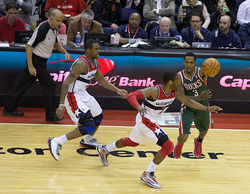Ridiculous NBA
 Aditya, Ben and Cody are playing basketball. Aditya starts the ball.
How many ways are there for them to pass the ball such that Aditya receives the ball at the 8th pass?
Aditya, Ben and Cody are playing basketball. Aditya starts the ball.
How many ways are there for them to pass the ball such that Aditya receives the ball at the 8th pass?
Details and Assumptions
No one can pass the ball to themselves
Image credit: Flickr Keith Allison
The answer is 86.
This section requires Javascript.
You are seeing this because something didn't load right. We suggest you, (a) try
refreshing the page, (b) enabling javascript if it is disabled on your browser and,
finally, (c)
loading the
non-javascript version of this page
. We're sorry about the hassle.
3 solutions
Exactly how I did it, including an identical table.
Let
t
n
be the number of ways to get the ball to Aditya after n passes.
Now consider two cases.
(i)The last pass of
t
n
−
1
must be received by Aditya. He can receive it from Ben or Cody.
Now suppose Ben passes the ball to Cody instead of Aditya and then Cody passes the ball to Aditya. We then get one of the possible configuration of passes in
t
n
. The same argument holds for Cody.
(ii)It is also possible that the ( n − 2 ) t h pass of the ball is received by Aditya. This is counted in t n − 2 . Then he can pass the ball to Cody or Ben (2 ways), and whoever receives the ball pass it back to Aditya. Again, we get one of the possible configuration of passes in t n . From the above 2 cases it is easy to see that, t n = t n − 1 + 2 t n − 2 ...(1)
It is obvious that t 1 = 0 and t 2 = 2 . ...(2)
Thus from (1) and (2), we get t 8 = 8 6 .
The number of ways 'n' passes can be made with the trivial condition that one cannot pass to oneself - is - same as arranging A,B,C with the condition that no two consecutive positions have the same letter. The number of such arrangements is 3x2^(n-1). When the condition that first letter can't be 'A', then number of arrangements is 2^n. Let T(n) be the number of arrangements such that 'n'th position is occupied by 'A'. Then number of arrangements such that nth position is not occupied by A is 2^n - T(n).
Therefore, T(n+1) = 2^n - T(n), T(1) = 0 and T(2) = 2.
T(3) = 2^(3-1) - T(2) = 4 - 2 = 2 T(4) = 8 - 2 = 6; T(5) = 16 - 6 = 10;
T(8) = 128 - 42 = 86
Nice solution
Define a n to be the number of ways to get the ball to Aditya after n passes and b n and c n to be the equivalents for Ben and Cody. Then a n = b n − 1 + c n − 1 , b n = a n − 1 + c n − 1 , and c n = a n − 1 + b n − 1 .
Here is an organized method to recursively find a 8 by passes made.
Thus, a 8 is equal to 8 6